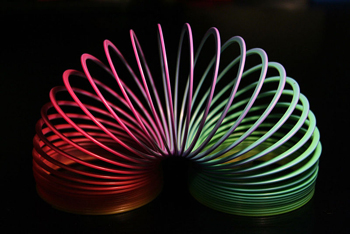The Trouble with Chemokine Receptors
| Chemokine receptors are G protein-coupled receptors that allow cells to migrate towards increasing chemokine gradients. They are vital in many processes of immune cells during their lifetime, including homeostasis and inflammation. Chemokine receptors are divided into different families based on the type of chemokine that they bind: CXC chemokine receptors, CC chemokine receptors, CX3C chemokine receptors and XC chemokine receptors. |
 |
| Structure What makes the chemokine receptor unique is its three dimensional structure in the context of the cell membrane. While most cell surface molecules are type I or type II single pass proteins, the chemokine receptors pass through the membrane seven times. This has several implications for the molecule:
|
 A slinky is probably more rigid than a chemokine receptor in the membrane. |
|
| So why is this troublesome? Antibodies. The successful production of chemokine receptor specific antibodies can be quite difficult, particularly if you are trying to develop an antibody for flow cytometry, which needs to recognize the protein in its native state in the membrane. The reasons mentioned above regarding the structure are likely reasons why it would be difficult. Furthermore, once you have generated an antibody, it can still be difficult to detect the receptor. The structure, or flexibility of the structure, may be the real culprit. |
|
| Imagine that you are an antibody looking for its chemokine receptor target on the cell surface. From the top view you might bind to an epitope that spans multiple loops like this (circled in red): If the positioning of those loops changes, even slightly, due to membrane lipid changes, temperature changes, glycosylation changes, or other influencing factors, one could easily see how the antibody might lose its binding ability: |
 |
| What can you do about it? Whether you are immunophenotyping, or blocking the receptor, you will need to start with good antibodies that are specific and have high affinity. BioLegend provides an excellent selection of anti-chemokine receptor antibodies, covering a majority of all receptors for mouse and humans. To give yourself confidence, verify them against other antibodies you may be currently using. There are also protocol techniques that can help you optimize staining:
|
|
| Learn more about Chemokines and Chemokine Receptors on our webpage. | |
The following papers are relevant, useful reading:
Contributed by Dzung Nguyen, PhD. |
|
 Login / Register
Login / Register 






Follow Us